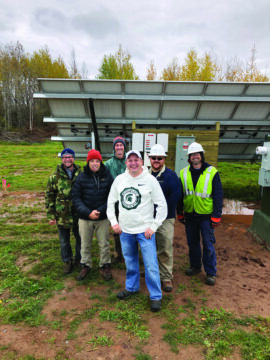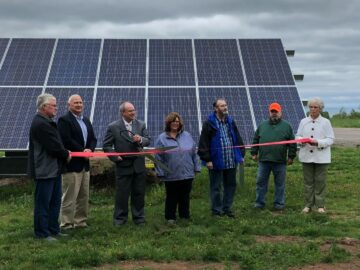October 05, 2022
Village of L’Anse: Making Solar Accessible to All
Member Utilities
By Liz Foley
This article was first featured in the September/October 2022 issue of “The Review,” the official magazine of the Michigan Municipal League, and reprinted with permission.
One small village’s very bright idea is lighting up the shores of Lake Superior’s Keweenaw Bay.
The L’Anse community solar project is a shining example of how even a small municipality can achieve huge results by leveraging the power of local partnerships and community engagement.
The 340-panel, 110.5-kilowatt solar array sits at the village’s Lambert Road Industrial Park just west of town, providing a green energy resource for its 1,752 residents. It is the first community in the western U.P. to do so, and the third in the entire Upper Peninsula, following the far larger communities of Escanaba and Marquette. The idea is to make renewable energy accessible to everyone, regardless of income.
 “This is for everybody. This is the thing that made it survive: that everyone was able to be a part of this,” said Village President Pro Tem LeAnn Davis. “This is how things work when you collaborate and get people involved.”
“This is for everybody. This is the thing that made it survive: that everyone was able to be a part of this,” said Village President Pro Tem LeAnn Davis. “This is how things work when you collaborate and get people involved.”
L’Anse is also one of only about 2,000 communities nationwide with its own municipal electric utility.
“Community-owned public power utilities are not-for-profit and have local control, which ultimately means that the utility is there for the good of the community, and is not driven by delivering profits for investors,” said Brett Niemi, WPPI’s Energy Services representative and project manager. “If a public power community wants to bring in more renewable energy into their portfolio, they have the opportunity to work through their local staff and local elected officials to accomplish that goal.”
WPPI is owned by L’Anse and 50 neighboring communities to answer local needs for reliable, affordable energy.
“By ourselves we might be relatively small, but by banding together, we can achieve economies of scale that allow us to act like a much larger entity,” said Village Manager Bob La Fave, who is also a PhD candidate in environmental and energy policy at Michigan Technological University.
First Steps to Solar
With his dissertation focused on clean/renewable energy transition, it was only natural that La Fave suggested village leaders consider adding a renewable energy component to their system. The first step was a small 110.4-kilowatt array at the water treatment plant. The village worked with WPPI to receive a grant for the array as a demonstration project in 2016.
“Research shows that municipal buildings are some of the largest consumers of electricity, and our water plant was a great way to impact our local energy consumption while passing the benefits of the array on to everyone in our community,” said La Fave. “Everyone gets a water bill, so savings through renewable energy deployment at the facility will help the village hold down rates—benefiting everyone. Our water comes from the Keweenaw Bay on Lake Superior, so it also makes one piece of pure Michigan a little more so.”
The demonstration project had a powerful ripple effect.
“This installation created buzz about solar in our community and led to the discussions which ultimately drove the partnerships that led to our community solar project,” said La Fave. “Having that proof of concept was really important…because even though Michigan Tech had a lot of data to show solar would work in the U.P., we had a local pilot that provided a proof of concept.”
Bringing in Michigan Tech University
The village partnered with Michigan Tech University faculty and students on the technical and social feasibility of the project. “This was a grassroots project. We’re a small rural village in the Western Upper Peninsula, so certainly we could not have done this alone. I was not afraid to reach out to potential partners to see if we had a fit,” said La Fave. “I would encourage other communities to reach out to colleges and universities in their areas—they may be able to do the same.”
The school’s Alternative Energy Enterprise students produced a report on potential costs and return on investment, and the suitability of the site itself. Then students in the social sciences department assessed whether there was sufficient interest in the community, and if so, how to design a program that they would participate in.
“So rather than coming into these meetings with a fully formed project that we were presenting to members of the community, we were really there to listen and to receive input,” said Associate Professor of Sociology Dr. Chelsea Schelly, in a video interview produced by the university. “We also in doing a survey of ratepayers here in the community, some of the survey data was collected by going door to door, which meant that there were students out in the community collecting these surveys, but also getting to hear from people right at their door about their different ideas or concerns. And that meant that we got a wider array of inputs and ideas than we would have if we had just had a meeting where we presented results and then asked for feedback on that.”
The public input helped shape everything from bill financing to price points and size. The result was a grassroots program where residents felt real ownership of the entire process.
“Get to know the needs and wants of the community before you build a solar PV array and design a program,” advised Niemi. “Through our outreach efforts we were able to determine where and how big to build the solar PV array and craft a financial model for a viable program that brought value to both the customers and the utility.”
How it Works
Organizations and individuals purchased shares in panels to receive credits from WPPI Energy for the power produced for the next 25 years. 250 of the 450 panels were set aside for income-qualified subscribers, with grant funding through the Michigan Solar Communities—Low to Moderate Income Access program (LMI) through the Michigan Department of Environment, Great Lakes and Energy (EGLE). Each LMI subscriber is allotted 10 panels at a cost of $0.90 per month per panel. In return they’re credited an average of $2.80-$3.30 per panel each month off their electric bill.
“Overall, each LMI customer will receive an estimated net of $643 of credit per panel over the 25-year term,” said Niemi. “All other customers pay an upfront, onetime fee of $385 per panel and receive an average of $2.80 – $3.30 of credit per panel per month (or $34-$39 of credit per year per panel). Overall, each customer will receive an estimated net of $528 of credit per panel over the 25-year term.”
The LMI program has had a real economic impact on the 25 participating local families, said Davis.
 “There isn’t a lot of wealth in this community. What industries do we really have up here? How much tourism can you depend on? We just don’t have the jobs,” said Davis. “It made it possible for those who really could not afford it, not just those who had the money to buy a panel.”
“There isn’t a lot of wealth in this community. What industries do we really have up here? How much tourism can you depend on? We just don’t have the jobs,” said Davis. “It made it possible for those who really could not afford it, not just those who had the money to buy a panel.”
All 340 panels are now spoken for amongst 48 households and organizations, including LMI subscribers, churches, schools, and individuals. Davis was one of the first to buy panels for herself and her adult daughter. Everyone on the village council owns at least one, she said. She hopes with continued public messaging, even more residents will want to participate. When that happens, they’ll be ready: the space was designed to double the size of the arrays if the need presents itself.
All said similar ideas are possible anywhere.
“I guess the big take-away is not to be afraid to have conversations,” said La Fave. “We didn’t know if this would work in the beginning, but as we moved along through the process, we learned that it would, and what it needed to look like.
“I think taking this approach to other areas of municipal governance projects can have the same effect. We’re not afraid of engagement in our community. That’s how this happened.”
Liz Foley is a freelance writer. You may contact her at 810.287.8549 or lizfoley2@gmail.com.
